Plant and Animal Cells 1 Pager: Clear, Practical Guide to Key Facts

The Enthusiast’s Master Class: Plant & Animal Cells Demystified (From Rookie to Pro!)
Imagine peering into a drop of pond water and suddenly realizing—there’s an entire universe bustling beneath the lens! My first taste of this world was in eighth grade, using a battered old microscope that hadn’t been cleaned since the Clinton era. But the magic it revealed? Unforgettable.

If you’ve ever felt bored or overwhelmed by another “plant vs animal cell” worksheet, get ready—I’m about to take you on a journey from basics to brilliance. By the end, you’ll not only know the differences and similarities; you’ll see cells as living settings for drama, innovation, and survival. Welcome to your plant-animal cell master class!
1. The Living Blueprint: Everything Starts With Cells
Let’s shake off any lingering textbook fatigue. Here’s what no teacher ever told me: understanding cells is less about memorizing parts, more like grasping why cities function differently—Paris isn’t New York for good reason!
Core Truths You Need to Know
- All living things are built from cells—that goes for blue whales, daffodils, you and me.
- Cells only come from other cells—a universal relay race.
- The cell is life’s fundamental unit—every heartbeat or leaf unfurl owes itself to these microscopic architects.
Back in 2019, I ran my own experiment: trying to draw an “average” plant cell on one side of a page, and an “average” animal cell on the other. It took seven tries before I stopped mixing up structures (and cursing at my sketchbook). If mistakes happen—I promise, they’re part of mastery!
2. The Shared Toolkit: What All Eukaryotic Cells Bring to the Table
Both plant and animal cells are eukaryotic—that means they’ve leveled up with internal compartments (organelles!) that keep life humming.
The Power Five:
- Nucleus: DNA HQ—the mayor’s office setting city policy.
- Cytoplasm: Gel-space filling every corner with action (like Times Square on New Year’s Eve).
- Cell Membrane: Flexible security fence deciding who gets in or out.
- Mitochondria: Power stations converting food into useable energy; pro tip: both plants and animals have these!
- Ribosomes: Minuscule protein builders—imagine robotic arms stacking Lego towers at breakneck speed.
My Twist: Imagine if one organelle failed…
- Mitochondria “strike”? Expect instant blackout! No energy = no function.
- Nucleus sabotage? Pure chaos—no instructions mean utter disarray.
This isn’t theory; it happens! Mitochondrial diseases in humans cripple muscles… crops with defective nuclei fail to grow straight… Learning WHY each part matters grounds your knowledge miles deeper than flashcards ever could.
3. Those Defining Differences: Where Plant and Animal Cells Part Ways
Here comes the crucial fork in the cellular road—a split shaped by function and evolutionary history:

Plant Cell Innovations
Cell Wall:
Rigid outer barrier made mostly of cellulose; feels like armor plating when you bite that crispy apple slice (~0.1mm thick). Gives strength so plants can defy gravity without bones!
Chloroplasts:
Solar panels packed with chlorophyll—the reason ferns glow green under summer sunbeams. These turn sunlight + CO₂ + water → sugar via photosynthesis—a trick animals never learned.
Large Central Vacuole:
One giant bubble filled with sap & minerals—it maintains turgor pressure (think inflated bike tire) so leaves stand firm instead of wilting like forgotten lettuce.
Animal Cell Game-Changers
No wall means flexibility—a key reason our bodies bend rather than snap! We also lack chloroplasts; eating sugars is faster than making them from scratch.
Animal cells usually have:
- Many small vacuoles for quick storage swaps
- Specialized tools like lysosomes (“clean-up crew”) and centrioles (“cell division directors”)
Sensory Memory Hack:
Close your eyes—imagine picking up a blade of grass (crisp/rigid), then squishing your cheek gently (soft/flexible). That tactile difference? Plant vs animal structure in action!
Speed Test Cheat Code
Is there a wall? Are there little green blobs? = Plant
No wall; round/irregular shape? = Animal
(I once set up a rapid ID station at a summer camp—the kids got 100% accuracy just by asking those two questions!)
4. From Novice to Natural: Stepwise Approach That Actually Works
Most guides stop at facts—but progression breeds expertise! Here’s how I coach students from zero knowledge to ninja-level confidence:
Beginner Tactics
-
Draw or Print Diagrams First
- Color code! Bright green for chloroplasts, brown lines for cell walls.
- Trace shapes until muscle memory sets in—I improved recall by doodling five minutes before bed!
-
Narrate Each Organelle
- Instead of reciting names (“nucleus… mitochondria…”), write cartoon captions:
- Nucleus: “I’m the boss!”
- Chloroplast: “I eat sunshine!”
- Vacuole: “I’m stuffed!”
- Instead of reciting names (“nucleus… mitochondria…”), write cartoon captions:
-
Make Your Own Analogy Table
Organelle Plant Animal Memory Trick Cell Wall Yes No Armor vs jelly Chloroplasts Yes No Green solar panels Large Vacuole Yes No/small Warehouse vs locker
Intermediate Methods
-
Link Structure–>Function
- Why do trees grow tall but dogs don’t? Thank the cell wall—and imagine running if every muscle was rigid as wood!
- Why does spinach wilt but beef stays chewy when cooked?
- Water escapes vacuoles = limp leaves.
- Meat has structural proteins = stays bouncy even after heat.
-
Self-Test With Real Objects
Hold up salad greens vs chicken breast next meal—challenge yourself or friends:
“Which organelle keeps this stiff/soft?” -
Find Outliers
Try researching red blood cells—they lose their nucleus as adults! Or discover protoplasts—in biotech labs scientists strip away plant walls for gene insertion experiments costing around $200 per culture kit (pricey science hack).
Mastery Level Habits
-
Teach It Back
Explaining concepts aloud—even to your goldfish—is proven to lock details into long-term memory. -
Invent Mnemonics
My favorite is “Plants Can Live Very Well”:
Plants → Cell wall
Can → Chloroplast
Live → Large central vacuole
Very Well! -
Explore Evolutionary Roots
Dive deep into endosymbiosis—when a bigger cell invited bacteria inside billions of years ago (~1–2 billion!). This marriage created mitochondria/chloroplasts still carrying their own DNA today (seriously!).
5. Unexpected Twists & Advanced Insights
Here’s where we separate casual learners from true aficionados:
Counterintuitive Fact #1:
Both plants AND animals use mitochondria—even though we think only animals need them! Plants munch through stored sugars nightly when photosynthesis switches off—it’s nature's version of Netflix bingeing after dark.
Counterintuitive Fact #2:
Not all plant cells have chloroplasts—you won’t find them in roots growing underground (no light!). Likewise, some single-celled protists blur lines entirely—a Euglena can switch between photosynthesis and snacking on smaller organisms if needed.
Sensory Detail Challenge:
Under high-powered microscopes during my undergraduate research year, I watched cytoplasmic streaming sweep chloroplasts along corridors within onion skin cells—it looked like tiny green submarines drifting downstream!
6. Tools & Resources That Actually Make You Smarter
Years spent tutoring taught me that picking THE RIGHT resource saves hours of frustration:
Absolute Must-Haves
- Campbell Biology textbook ($150 new; worth it for visuals)
- Cells Alive – interactive models let you rotate organelles
- HHMI Biointeractive – real scientist videos explaining concepts
- iPad app “Cell Explorer”—draw directly on digital diagrams
- DIY home lab kits ($29–$79): make wet mounts with onion skin/mouth swab under a $40 pocket microscope
- Quizlet sets built around case studies—not just definitions—for active learning!
Want free extras? Print blank Venn diagrams whenever stuck comparing structures—it works wonders even at university level.
7. Mistakes I Made & How You Can Dodge Them
Sharing my biggest miscues so YOU skip unnecessary struggle:
Failed First Attempt: In high school bio I thought all green meant chlorophyll—but turns out some dyes fool the eye! Solution? Stain slides with iodine or methylene blue for clearer contrast under light scopes (~$10 bottle lasts all semester).
Mistake: Memorizing lists instead of functions—left me blank during application questions (“What would happen if vacuoles burst?”) until I started telling myself stories (“Warehouse spill floods factory floor!”).
Trap: Forgetting context—memorizing facts without knowing why they're useful makes lessons fade fast post-exam day…
8. Real-Life Case Studies That Make Concepts Stick
Lettuce Snap vs Spinach Slump
Buy both veggies fresh at your local store (~$3 each). Snap lettuce near your ear—the crunch comes from water-packed vacuoles pressing against sturdy walls! Steam spinach leaves—they collapse because those vacuoles deflate under heat while animal muscle remains resilient thanks to protein scaffolding alone.
Human Endurance Machines
Run three flights of stairs and feel your legs burn—that's thousands of mitochondria per muscle cell firing overtime! Compare that mental image with tree bark—they endure storms by rigidity rather than constant repair… different evolutionary priorities coded right down at cellular scale.
My Favorite Classroom Experiment
Asked students which would rot faster—a peeled potato chunk or raw chicken cube left overnight outside (don’t try this indoors…). Potato holds shape longer due to tough walls; meat quickly sags as soft animal membranes give way… sometimes science stinks literally but lessons stick forever!

9. Troubleshooting For Any Roadblocks
- Foggy about which organelle does what? Group them by job type (energy makers / builders / clean-up crew).
- Too many details swirling? Anchor yourself by focusing on 3 core differences first before diving deeper.
- Struggling with diagrams looking same-y? Use bold colors + label every part personally ("This blob = warehouse!") until they feel distinct in your mind's eye.
- Forgetting pros/cons? Set time-based goals—for instance:
“By Friday night I'll be able to explain why animal wounds heal differently from plant ones.”
10. Your Next-Level Action Plan
To move beyond trivia toward genuine expertise:
1️⃣ Draw out both types side-by-side weekly until differences become second nature
2️⃣ Summarize each new fact IN YOUR OWN WORDS after every study session
3️⃣ Invent cartoon superheroes inspired by organelles (“Chloro-Man zaps villains with sunlight!”)
4️⃣ Teach siblings/friends using kitchen produce as demo materials
5️⃣ Try interactive online quizzes monthly
6️⃣ Take mindful walks outdoors—or stare at your hand—and imagine millions of working parts beneath surface
And finally—reach out online (Reddit r/biology rocks!) whenever curiosity sparks new questions… experienced science lovers are everywhere waiting to help you level up further.
Visual Summary Table — The Ultimate At-A-Glance Reference
| Organelle / Feature | Function | PLANT CELL | ANIMAL CELL |
|---|---|---|---|
| Nucleus | Control center/DNA | ✔️ | ✔️ |
| Cytoplasm | Reaction space | ✔️ | ✔️ |
| Cell Membrane | Gatekeeper | ✔️ | ✔️ |
| Cell Wall | Rigid support | ✔️ | 🚫 |
| Chloroplast | Sunlight-to-food conversion | ✔️ | 🚫 |
| Large Central Vacuole | Storage/shape maintenance | ✔️ | 🚫 |
| Small Vacuoles | Storage | Few/small | Many small |
| Mitochondria | Energy maker | ✔️ | ✔️ |
| Ribosome | Protein builder | ✔️ | ✔️ |
| Lysosome | Clean-up crew | Rare | Common |
Final Word: From Curiosity To Cellular Confidence
Every apple crunch and marathon run tells a cellular story now visible through your lens—a lens sharpened not just by studying facts but by understanding life’s ingenious adaptations first-hand.
Bookmark this guide as your go-to reference—but don’t stop here! Each observation peels back new layers, whether spotting greenish veins on maple leaves or pondering why lizards shed skin so easily compared to oaks losing their bark.
Learning doesn’t end when exams do—it transforms daily encounters into discovery after discovery.
So next time someone groans over biology homework, share what you’ve unlocked here—and watch confusion morph into fascination.
Ready for another deep dive soon?
Keep exploring, keep questioning... because mastery isn’t an endpoint—it’s an adventure only true enthusiasts enjoy every step of the way!





